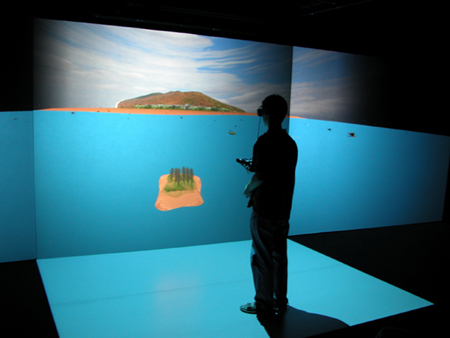Professor uses Envision Center to stimulate, teach students
By Sheryl Israel
Purdue Exponent
July 14, 2006
 |
Flying the simulation |
In the spring of 2007, the Envision Center will be bugging Jeffery Holland's students.
Holland, assistant professor of entomology, and affiliates of the Purdue Envision Center have been working to create a virtual reality program to model an ecological simulation.
Holland plans on using this simulation in the Biodiversity ENTM 320 class he teaches in the spring of 2007.
"I trying to model ecology phenomena that is very dynamic and hard to follow with a graph or formula," Holland said.
Holland is using the Envision Center to create a complete ecological experience that immerses the user into the environment.
"It is a great way to teach, I'm researching it and hope it's a great tool to us."
When Holland first proposed the project to the Envision Center, he needed help to create the simulation. Laura Arns of the Envision Center and graduate students Matt Brisbin and David Foldes provided the bridge to take Holland's vision and make it reality.
The main goal of the project is to make a virtual reality model the makes it easier for students to see three dimensional models, said Holland.
Foldes and Brisbin are creating the graphics for the simulation. Brisbin focuses on the modeling and textures of the insects in the program.
"I take reference pictures of the real insects and create them in 3-D from the pictures. Same goes with the texture. I just paint the texture onto (the insects)," he said. Foldes focuses on the environment in the program.
When students use this simulation in class, Holland said they will be able to be fully immersed in the environment and see the effects of a dynamic ecological system.
"The simulation presents students with a graphic representation with the things we are studying," Holland said.
Holland thinks this program excite students and he also thinks it will help the learning process of complex material.
"Some theories are fairly intuitive that things move around," he said. "The dynamics of a system show that things change through time and as you change parameters, the whole way the system changes and models show that very nicely."
Holland hopes that the model of this project will lead to other uses in the future.
"We are already looking for other ways of using the simulation," he said. "We are developing a research tool explaining management techniques and the spread of the emerald ash borer." |